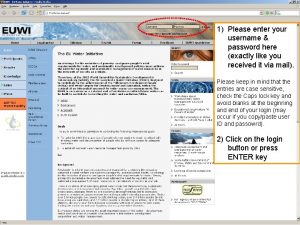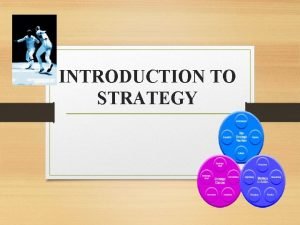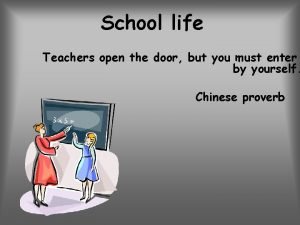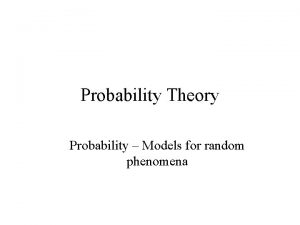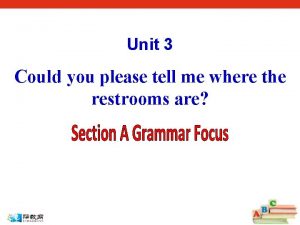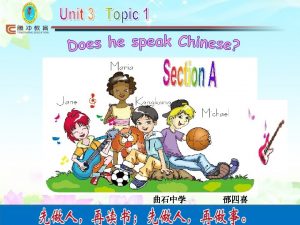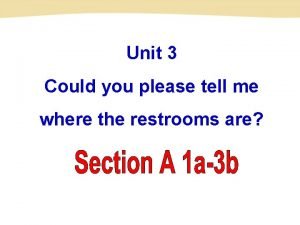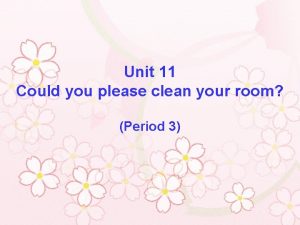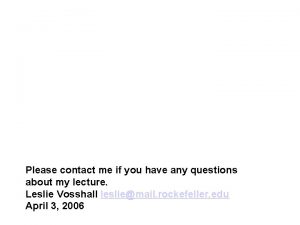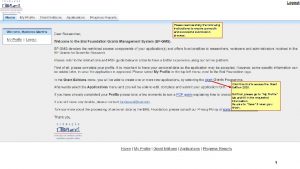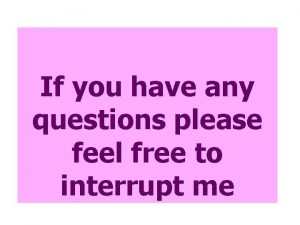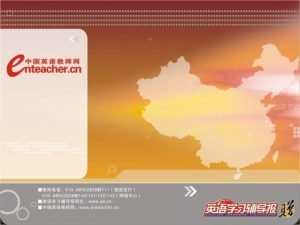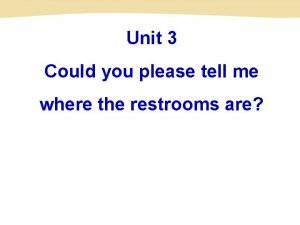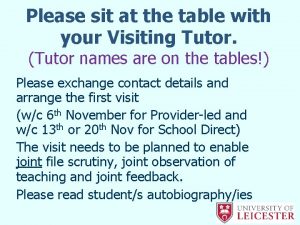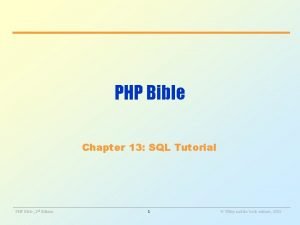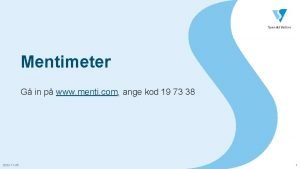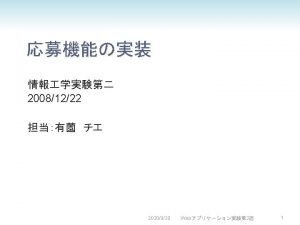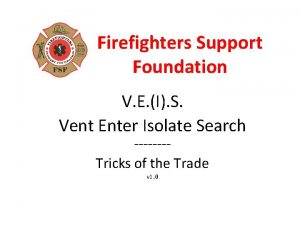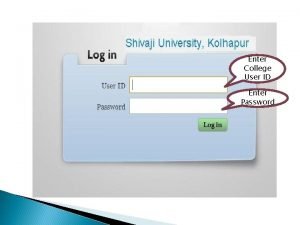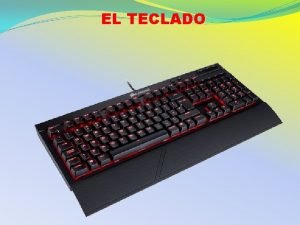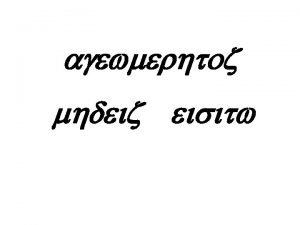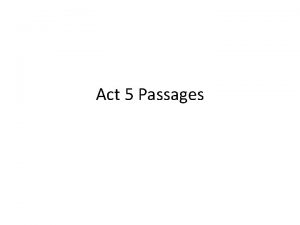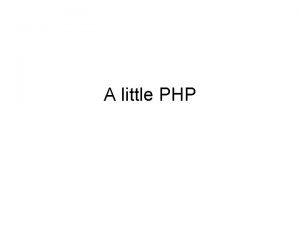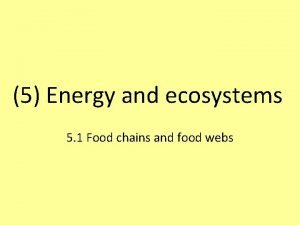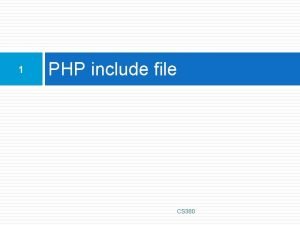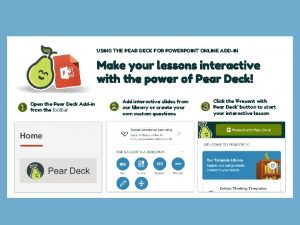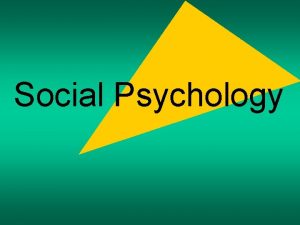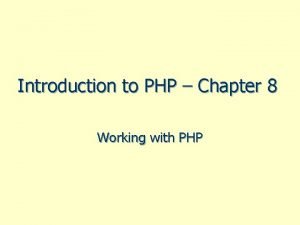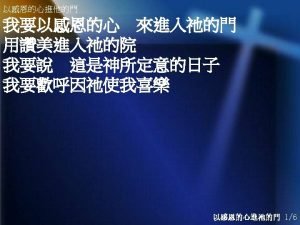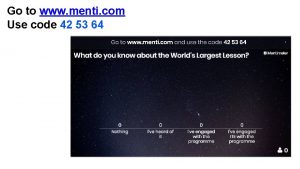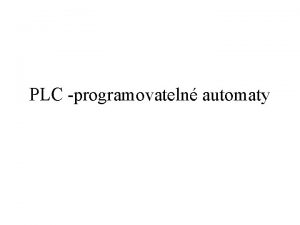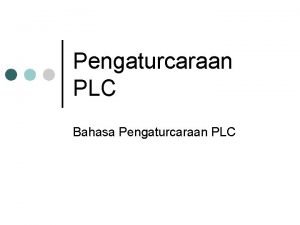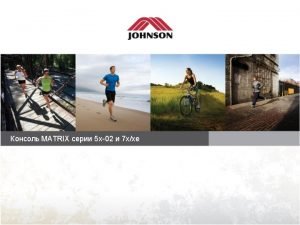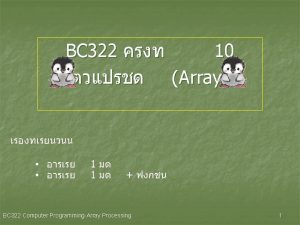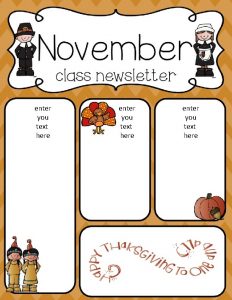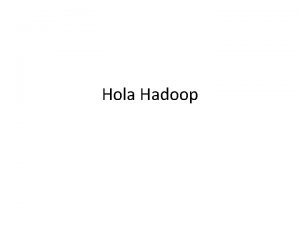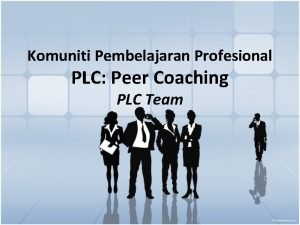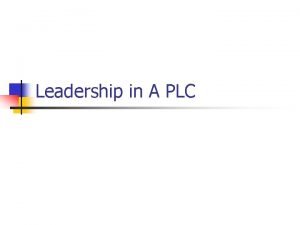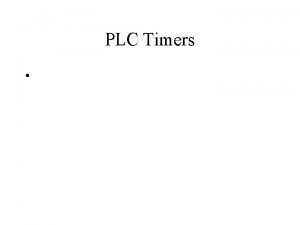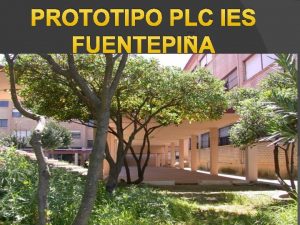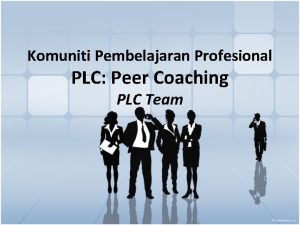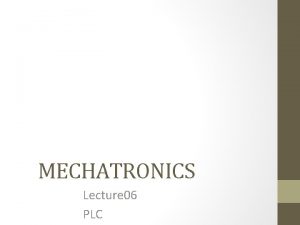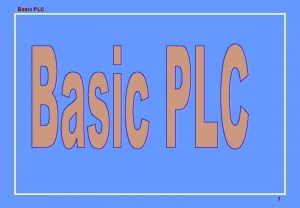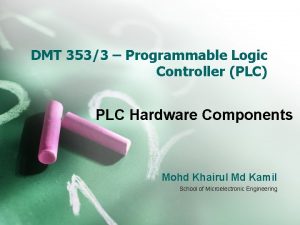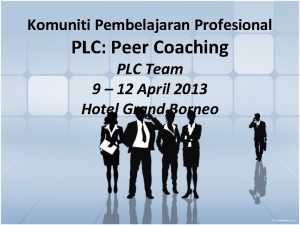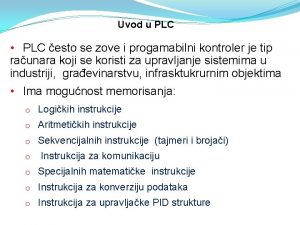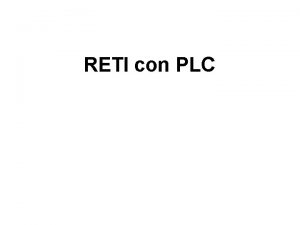What is a PLC As you enter please

















































- Slides: 49

What is a PLC? As you enter, please take a sticky note and place it on the chart in the column that best describes your comfort level in a PLC?


Collaborative Practices: Professional Learning Communities Session Objectives: Objectives/Outcomes 1. K‐ 12 teacher participants will distinguish between professional learning communities and different types of teams. 2. K‐ 12 teacher participants will know and be able to use district established protocol to guide the work of professional learning communities. 3. K‐ 12 teacher participants will be introduced to PD 360 group tools for the purpose of collaboration.

Setting Norms and Accountability Protocol Tips for Creating Norms: 1. Created by the PLC 2. Commitment act or behave a certain way 3. Reviewed regularly 4. Formally evaluate the effectiveness 5. Focus on a few essential norms 6. Address violations Source: All Things PLC Blog‐ Do We Have Team Norms of Nice To Knows by Kenneth Williams and Learning By Doing, Du. Four, Earker, Many

Norms ‐concern how team members will interact, communicate, and conduct themselves as members of the team. ‐‐provide a context for discussing grievances about team behavior. ‐gives team members an opportunity to express what's important to them and to learn what's important to their teammates.

PLC Session Sorting Activity

A PLC is… • • • Educators work collaboratively in regularly scheduled team meetings and evaluate their team functioning periodically Learning from students and related data in order to make changes in instruction that will improve student learning Effectiveness is measured by student results not intentions Collaborative teams working on a common goal aligned to the school improvement goals Based on agendas that are derived from data Use of a variety of tools and learning designs such as protocols or templates for looking at student work, unit planning, lesson study, coaching Following a model for continuous cycle of improvement Action‐oriented in terms of implementing new strategies; experimenting; conducting action research; follow‐‐‐up Using a data teams process Using evidence‐‐‐based best practice strategies Meeting during the school day Focusing on learning (adult and student)

PLC Continuum Using the Continuum, rate the PLC that you participated in this year. Keep in mind that the Accomplished Level is a goal.

Roles and Roleplay Making Professional Learning Communities Work

At EVERY Meeting • Facilitator • Time‐Keeper • Note‐Taker

Roles to Consider • • El Capitan The Rounder The Voice of Reason Johnny Notes Sister Sunshine The Skeptic Clarified Butter

El Capitan • Designs Meeting Agenda – Shares at least two days before • Guides Members through Agenda • Communicates with others on behalf of PLC

The Rounder • Keeps the team on task • Redirects the work of the group • Ensures meetings start and stop on time

The Voice of Reason • Ensures that projects are within the scope of limitations of what can be accomplished • Demands prompt attention when projects begin to get too complicated • Enforce the KISS strategy

Johnny Notes • Keeps track of all important decisions in meetings • Notes who is present • Stays organized

Sister Sunshine • Smiles • Reminds everyone of their excellence • Stays positive

The Skeptic • Forces team to consider things we haven’t thought of yet. • Asks hard questions

Clarified Butter • Listens carefully • Brings closure to decisions • Summarizes work before, during and after meetings

Role Wrap‐Up • Facilitator role rotates • Everyone has a role

Role… Roleplay Your PLC has one member who doesn’t attend to the work. She comes to each meeting late and with papers to grade. She doesn’t participate in meaningful conversation. When she does speak, it is to complain about being forced into a PLC and about the administration.

Role… Role. Play One member of your group assumes the role of facilitator at every meeting. He is well intended but it has caused the rest of the group to “check ‐out. ” He seems to do the majority of the work. You are concerned that the PLC is not functioning as well as it could and that members are not learning. What do you do?

PLC ROLES FACILITATOR

Facilitator This role helps the group stay on task and move towards the goals set by the PLC team. They also assure that everyone is actively participating, and understands the goals the group is working to accomplish for the PLC or individual meeting.

A FACILITATOR: • provides levels of support and guidance to the team • ensures pacing • helps to motivate and maintain enthusiasm • keeps the PLC focus or goals on track • facilitates collaboration around the data sources agreed upon by the team • is an important component in the success of a PLC

A FACILITATOR IS NOT: • • • in command or have control over the group necessarily one person or one role fixed necessarily the team leader solely responsible for maintaining team norms

THE ROLE OF THE FACILITATOR • is an evolving one, the role may change depending on the different stages of the PLC. In addition the role may change depending on the type of PLC or goals set forth by the team.

SMART Goals Resources www. ritap. org/ritap/content/plc_presentation-nov_2005 -john_golden. ppt http: //www. ehow. com/print/info_8064411_smart‐goals‐professional‐learning‐communities. html

A PLC shares best practices as a means of improving instruction. “The PLC concept is specifically designed to develop the collective capacity of a staff to work together to achieve the fundamental purpose of the school: high levels of learning for all students. Leaders of the process purposefully set out to create the conditions that enable teachers to learn from one another as part of their routine work practices. Continuous learning becomes school based and job embedded. ” On Common Ground, page 18

Setting Goals • • Common Needs New Initiative School Improvement Plan Subject Area Evaluation

Writing Goals

Use these questions as a checklist. They will assist with planning the specific steps to be achieved on the way to accomplishing a goal. q Why did I choose this goal as a priority? q What help, assistance or collaboration q What are potential areas for changes in do I need? my practice? q What resources can help me? q What do I need to do to achieve this q How can I make this work? goal? q Have I checked out my assumptions? q What is the activity to be q Is this the best way of achieving this accomplished? goal? q Who is responsible for each activity? q What obstacles might block the q What information and knowledge do I attainment of the goal? q How will I know that I have learned? need?

Is the Goal Specific? • Specific means detailed and focused. Everyone reading it should know exactly what is to be achieved and accomplished.

Is the Goal Measurable? • Measurable goals are quantifiable. They provide a standard. Being “better” is too ambiguous. How do you know when you are “better”? What is enough?

Is the Goal Attainable? • Realistic goals are practical and achievable. A goal should stretch you, but not so far that you will be discouraged before you even start.

Is the Goal Results-Focused • The goal should specify a desired outcome or accomplishment, not the activities used to get there.

Is the Goal Time‐Bound? • Including a deadline allows PLC members to better plan an instructional timeline for achieving the goal.

Activity B A

Which Goal is SMART? A. By May 2015, I will increase technology integration in my lessons by at least 25% using ISTE standards and i. Pads. B. By May 2015, I will increase technology integration in my lessons by 40%, as evidenced by lesson plans and observations.

Which Goal is SMART? A. By January 2016, I will reduce discipline referrals in my third period class by 30%, which will be evidenced by classroom discipline logs and office discipline data. B. To develop and implement a guidance plan that addresses academic counseling, increases parent communication and creates & utilizes a procedural system for counseling tasks.

Which Goal is SMART? A. The insight gained on ASD students through this reading will assist us in allowing our ASD students to be more successful in school. B. By January 2015, I will include questions at the evaluating and creating levels in at least 80% of my lessons, which will be evidenced by lesson plans, observations, and peer coach feedback and notes.

Which Goal is SMART? A. To develop and implement a plan for the 9 th grade class to reduce the 2013‐ 14 retention rate from 9% to 5%. The 9 th grade class affected will include all students enrolled as 1 st time 9 th grade students as of August 19, 2013 and remaining for the 2013‐ 14 school year. B. Questioning is an important skill across curriculum. Our PLC will focus on effective questioning in the classroom. We discussed the articles that we read from Edutopia.

A PLC uses “assessment for learning” in addition to the usual “assessment of learning. ” Research reveals that significant improvement occurs in student learning when the following classroom assessment practices are in place. • Sharing clear and appropriate learning targets with students from the beginning of learning. • Increasing the accuracy of classroom assessments of the stated targets • Making sure that students have continuous access to descriptive feedback • Involving students continuously in classroom assessments, record keeping, and communication processes. Rick Stiggins as quoted in On Common Ground, page 67

Smart Goal Worksheet

Elementary Sample

Middle School Sample

High School Sample

Documenting PLCs Prior to beginning any Professional Learning Community (or any Professional Activity), ensure it is entered into My. Learning. Plan. We have created a form to help you. 1. Login to www. mylearningplan. com 2. Use the left‐hand side to find the “Professional Learning Community Request” form. 3. Complete the form and press submit. 4. Notify your school‐based PD contact who will approve it for entrance into MLP. 5. Document your PLC through PD 360.

PD 360 • Overview of the Groups Application ‐ http: //www. pd 360. com/index. cfm? Content. Id=3736

Closing Activity Sticky Note Exit Slip/Gallery Walk • School Name • What will you change as a result of this training? • What additional training does your school/PLC need?
 Please be quiet. i (try) to sleep
Please be quiet. i (try) to sleep Please enter your username
Please enter your username Please enter the missing figure: 13, 57, 911, 1315, 1719
Please enter the missing figure: 13, 57, 911, 1315, 1719 Chinese proverb teachers open door
Chinese proverb teachers open door Expressways have expressway entrance
Expressways have expressway entrance The cave you fear to enter
The cave you fear to enter You and your mom enter a drawing with 3 different prizes
You and your mom enter a drawing with 3 different prizes Could you please tell me where
Could you please tell me where Please clean your room
Please clean your room The church of please and thank you
The church of please and thank you Excuse me this is my room 56
Excuse me this is my room 56 Officious fool
Officious fool Could you tell me where is the bookstore
Could you tell me where is the bookstore Please clean the room before you live
Please clean the room before you live Please clean your room
Please clean your room Please clean your room before we leave for school
Please clean your room before we leave for school Please contact me if you have any questions
Please contact me if you have any questions Can you please turn off
Can you please turn off Help me you to the put picture can here please
Help me you to the put picture can here please Please read instructions carefully before use
Please read instructions carefully before use If you have any questions please feel free to interrupt me
If you have any questions please feel free to interrupt me Would you please tell me where the mall is
Would you please tell me where the mall is Excuse me could you tell me the way to the national museum
Excuse me could you tell me the way to the national museum Will you please sit at the table
Will you please sit at the table Do you love the rain
Do you love the rain Agree or disagree questions about life
Agree or disagree questions about life If you think you can you can poem
If you think you can you can poem Tell me what you eat and i shall tell you what you are
Tell me what you eat and i shall tell you what you are I will follow you wherever you ...........................
I will follow you wherever you ........................... Bible database sql
Bible database sql Www..menti.com
Www..menti.com Php //input
Php //input Why didn t moses enter the promised land
Why didn t moses enter the promised land Veis fire
Veis fire Enter his gates with thanksgiving song
Enter his gates with thanksgiving song What is passphrase of college
What is passphrase of college El teclado es un dispositivo de:
El teclado es un dispositivo de: Lever balance in complete denture
Lever balance in complete denture Let no one enter who is ignorant of geometry
Let no one enter who is ignorant of geometry O mischief thou art swift
O mischief thou art swift Abandon all hope ye who enter here
Abandon all hope ye who enter here Html code
Html code How does energy enter an ecosystem? *
How does energy enter an ecosystem? * Enter.php?incl=
Enter.php?incl= Joinpd.com code
Joinpd.com code What is the longest river in northern ireland
What is the longest river in northern ireland Personal attitudes and dispositions also shape behavior
Personal attitudes and dispositions also shape behavior File.php?chapter=
File.php?chapter= I will enter his gate with thanksgiving
I will enter his gate with thanksgiving Www menti com code
Www menti com code

